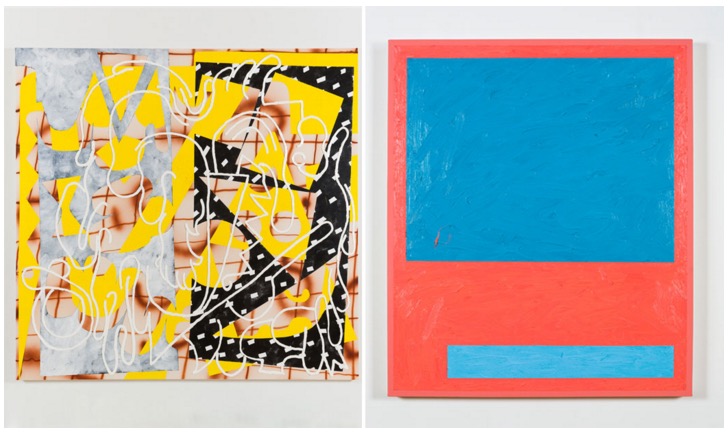Tangible Textures: Trudy Benson and Russell Tyler at Retrospective Gallery
By Dana Kopel
Posted on September 17, 2015 and printed in November Issue.
Trudy Benson’s “Invisible Man,” 2015 and Russell Tyler’s “TBP,” 2015.
In this two-person show, on view at Retrospective Gallery in Hudson, NY through September 20, recent works by Trudy Benson and Russell Tyler engage the materiality and referentiality of painting. Both artists’ works take into account the ways the Internet has reshaped images and how we process and understand them, yet the exhibition uses texture as an argument for the ongoing necessity of painting—in its tangible (and salable) form, dependent upon the physical experience of canvas and paint.
Benson’s paintings are each composed of several layers, which overlap, interrupt, and peek through each other like a Photoshop collage in progress. In Invisible Man, 2015, a large canvas is covered with a haphazard rust-colored grid and spray-painted squiggles; atop this, sections in patterned black and white, yellow stucco effect, and swirling shades of gray intersect, while cut-out shapes reveal the colors and patterns of the layers beneath them. On top of everything, a thick line of white paint, as if squeezed out of a toothpaste tube, forms an organic, cartoonish design from which corporeal forms—fingers, a hand, what might be an ear—emerge. Benson’s other paintings on view likewise feature combinations of painting techniques, colors, and patterns; their surfaces, which can seem flattened and blandly imagistic online, reveal texture and resonance in the physical gallery space.
Tyler’s works also deploy the materiality of paint toward a reconsideration of painting post-Internet. Apparently inspired by the spatiality of digital platforms, the richly colored, impasto paintings—both geometric and gestural abstractions—appear more interested in modernist art than digital space. 3BS, 2015, a work in shades of blue, roughly appropriates the form of Albers’s Homage to the Square, except that Tyler’s canvas and painted shapes are rectangular and his medium is applied in thick, swipe-like strokes. Several other pieces also feature bright rectangular forms, floating at opposite ends of the canvas or stacked on top of one another like a rigid, obsessive Rothko. In more than one instance a glob of paint has landed, as if by accident, on a rectangle of another color—blue on yellow, or neon reddish pink on blue—to suggest, presumably, the imperfection of the real.
A version of this article appears in the November 2015 issue of Modern Painters.

